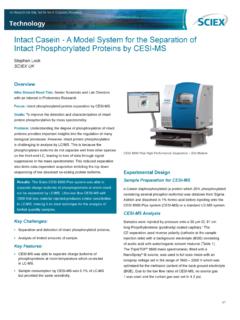Transcription of Basic considerations in the dermatokinetics of …
1 *Correspondence: Anroop Nair. Department of Pharmaceutical Sciences, Col-lege of Clinical Pharmacy, King Faisal University, 400, Al-Ahsa-31982, Kingdom of Saudi Arabia. E-mail: Journal of Pharmaceutical Sciencesvol. 49, n. 3, , 2013 Basic considerations in the dermatokinetics of topical formulationsAnroop Nair1,*, Shery Jacob2, Bandar Al-Dhubiab1, Mahesh Attimarad1, Sree Harsha11 Department of Pharmaceutical Sciences, College of Clinical Pharmacy, King Faisal University, Al-Ahsa, Kingdom of Saudi Arabia, 2 College of Pharmacy, Gulf Medical University, Ajman, United Arab EmiratesAssessing the bioavailability of drug molecules at the site of action provides better insight into the efficiency of a dosage form.
2 However, determining drug concentration in the skin layers following topical application of dermatological formulations is a great challenge. The protocols followed in oral formulations could not be applied for topical dosage forms. The regulatory agencies are considering several possible approaches such as tape stripping, microdialysis etc. On the other hand, the skin bioavailability assessment of xenobiotics is equally important for topical formulations in order to evaluate the toxicity. It is always possible that drug molecules applied on the skin surface may transport thorough the skin and reaches systemic circulation. Thus the real time measurement of molecules in the skin layer has become obligatory.
3 In the last two decades, quite a few investigations have been carried out to assess the skin bioavailability and toxicity of topical/dermatological products. This review provides current understanding on the basics of dermatokinetics , drug depot formation, skin metabolism and clearance of drug molecules from the skin layers following application of topical : Dermatological formulations/pharmacokinetics. Dermatological formulations/ toxicity. dermatokinetics . Skin/metabolism. Microdialysis. Tape stripping. A avalia o da biodisponibilidade de mol culas de f rmacos no s tio de a o oferece melhor compreens o sobre a efici ncia da forma de dosagem. Entretanto, a determina o da concentra o de f rmaco nas camadas da pele em seguida aplica o t pica de formula es dermatol gicas um grande desafio.
4 Os protocolos seguidos para as formula es orais n o podem ser aplicados para as formula es t picas. As ag ncias regulat rias consideram v rias abordagens poss veis, tape stripping, microdi lise etc. Por outro lado, a avalia o da biodisponibilidade de xenobi ticos na pele igualmente importante para as formula es t picas para se avaliar a toxicidade. sempre poss vel que as mol culas de f rmaco aplicadas na superf cie da pele sejam transportadas atrav s da pele e alcancem a circula o sist mica. Assim, a medida em tempo real de mol culas na camada da pele tem se tornado obrigat ria. Nas ltimas duas d cadas, realizaram-se poucas pesquisas para avaliar a biodisponibilidade da pele e a toxicidade de produtos t picos/dermatol gicos.
5 Esta revis o fornece a compreens o atual com base na dermatocin tica, forma o de f rmaco de dep sito, metabolismo da pele e o clearance das mol culas de f rmaco das camadas da pele em seguida aplica o de formula es t : Formula es dermatol gicas/farmacocin tica. Formula es dermatol gicas/toxicidade. Dermatocin tica Pele/metabolismo. Microdi lise. Tape stripping. INTRODUCTIONT opical dermatological formulations are primarily intended to deliver therapeutically effective concentration of drug in skin layers, which are also the target site. Indeed, treatment of superficial skin diseases such as fungal infections could be accomplished with topical formulations.
6 Many dermatological formulations are available and are specifically designed to exert local effect in the diseased skin, rather than diffusing into the deeper layers of skin. Primarily these formulations are aimed to deliver a therapeutically effective drug concentration in the target tissue, to exert a local effect, following topical application. However, the presence of several excipients which are potential to solubilise the outer skin layers allows the entry of drug moieties in the deeper skin layers A. Nair, S. Jacob, B. Al-Dhubiab, M. Attimarad, S. Harsha424and even into systemic circulation. Novel vesicular formulations such as micro-emulsions, liposomes, and nanoparticles have demonstrated the potential to enhance cutaneous drug delivery of both lipophilic and hydrophilic drugs (Riviere, Brooks, 2011).
7 It is understood that the properties of both formulation and drug are equally important in deciding the disposition of drug in the skin layers. Hence, it is likely that the individual drug molecule and excipient could exhibit different permeability behaviour (Desai et al., 2010). In addition, the presence of enzymes in skin causes variation of the structure of molecules and alters topical bioavailability. Hence, the in vivo activity of dermatological formulation depends on bioavailability of drug within the skin at the site of action (Bronaugh et al., 1994). In this context, researchers in the last few decades have given much emphasis on the assessment of skin kinetics of topical formulation.
8 Following application of a topical drug formulation to the skin surface, it is likely that few processes occurs in a sequence such as release of drug from the dosage form, permeation of the drug into the skin barrier and exhibits the therapeutic responses such as onset of action, duration and magnitude of traditional methods for assessing the kinetics in blood, plasma or urine may not be viable as most of the topically applied molecules may not produce measurable concentrations in extra cutaneous biological fluids. It should also be remember that in topical therapy the drug concentration in the skin can significantly exceed free concentrations in plasma as the topical formulations deliver the drug directly to or near the intended site of action.
9 Hence, determining drug absorption and elimination from the stratum corneum (SC) could be more promising. Thus, an ideal method to assess the skin kinetics would be a technique which allows non-invasive determination of rate and extent of drug within the skin. On the other hand, assessment of the rate and extent to which an active molecule attains its site of action in the target area (skin layers) is not considered as an easy task, due to the non availability of a simple and precise method for sampling the drug molecules from this assessment of topical formulations remains a great challenge. Regulatory agencies like US Food and Drug Administration (FDA) have been exploring different strategies for the bioequivalence assessment of topical dermatological formulations.
10 One of the methods suggested by FDA is the dermatopharmacokinetic (DPK) approach, wherein the drug concentration in the skin is determined continuously or intermittently for a period of time. Alternatively, microdialysis technique has been introduced to dermatological research as a valuable in vivo tool to assess the skin kinetics of topical formulations (Anderson et al., 1991; Kreilgaard, 2001). Further, several in vivo approaches have been also assessed to measure the topical bioavailability. This article provides a valuable insight into the Basic considerations in the dermatokinetics of topical BARRIERSSkin is the largest organ of human body, which also act as a boundary between body and environment.















